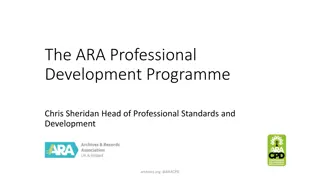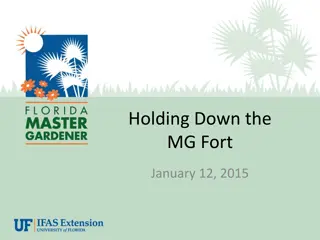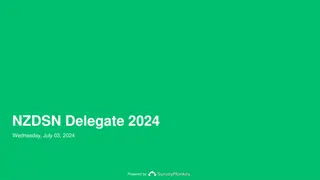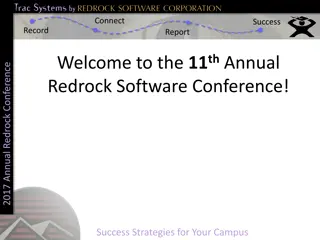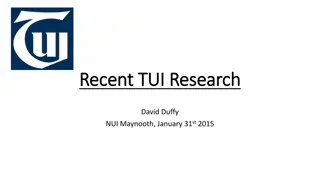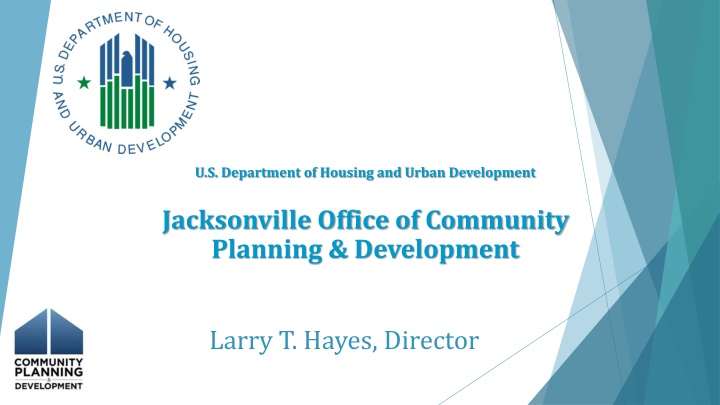
Empowering Communities Through Housing and Urban Development Programs
The U.S. Department of Housing and Urban Development's Jacksonville Office of Community Planning & Development, led by Director Larry T. Hayes, oversees programs aimed at benefiting low- and moderate-income individuals and households. These initiatives focus on providing decent housing, suitable living environments, and economic opportunities. Funding through various CPD formula programs supports local residents in shaping their communities, combining housing and community development for holistic improvements. The Community Development Block Grant (CDBG) is a key program offering flexible funding to address national objectives and support economic development.
Uploaded on | 5 Views
Download Presentation

Please find below an Image/Link to download the presentation.
The content on the website is provided AS IS for your information and personal use only. It may not be sold, licensed, or shared on other websites without obtaining consent from the author. If you encounter any issues during the download, it is possible that the publisher has removed the file from their server.
You are allowed to download the files provided on this website for personal or commercial use, subject to the condition that they are used lawfully. All files are the property of their respective owners.
The content on the website is provided AS IS for your information and personal use only. It may not be sold, licensed, or shared on other websites without obtaining consent from the author.
E N D
Presentation Transcript
U.S. Department of Housing and Urban Development Jacksonville Office of Community Planning & Development Larry T. Hayes, Director
Community Planning & Development (CPD) Provides oversight of programs designed to benefit low-and-moderate income(LMI) individuals and households to develop viable communities by providing: Decent housing Suitable living environments Economic opportunities 1) 2) 3) Funding through this division gives voice to local residents in the futures of their communities. Combines Housing and Community Development for a more comprehensive, planning approach in improving lives and communities. Funding is available through formula and competitive allocations
CPD Formula Programs CDBG HOME HTF ESG HOPWA RHP CoC Community Development Block Grant HOME Investment Partnerships Program Housing Trust Fund Emergency Solutions Grant Housing Opportunities for Persons with AIDS Recovery Housing Program Continuum of Care Program *Note This is not a complete list of CPD funds
Community Development Block Grant (CDBG) Activities funded with CDBG MUST meet one of three national objectives: Principally benefit low- and moderate-income persons (household incomes do not exceed 80% median income); Aid in the prevention or elimination of slums or blight; or Meet an urgent need by addressing conditions that pose a serious and immediate threat to the health and safety of residents. Eligible activities: o Public services, public facility and infrastructure improvements, commercial facades, homeowner and rental repairs/rehabilitations, acquisition, and economic development for job creation/retention. Flexible, block grant funding provided to states and eligible localities. Central cities of Metropolitan Statistical Areas (MSAs), other metropolitan cities with populations of at least 50,000, and qualified urban counties with populations of at least 200,000 (excluding the population of entitled cities) are entitled to receive annual grants. o 70% of the program funds are granted to general units of local government. o 30% of program funds are granted to states based on a separate formula allocation for disbursement to communities that do not qualify for entitlement funds. Funding helps to make communities more resilient long-term. o o o
CDBG Programs and Economic Development Section 108 Guarantee Loan Program Microenterprise Development o Technical Assistance to Businesses o Capital Access/Revolving Loans Section 3 Program
Section 108 Loan Guarantee Program Financial tool for local governments and states to borrow guaranteed funds (low-cost and flexible) from HUD (up to 5 times their current CDBG allocations) after satisfying application and project underwriting criteria. o Proposed projects should have sufficient cash flow to repay the loan without current or future dependency on CDBG contributions. Notes are repaid with pledged current and future CDBG funds, program income, and/or other revenues as security for the loan. Promotes leveraging with other public and private funds to finance economic development, housing, public facility, and infrastructure projects in distressed areas. Interested governments seeking to apply are encouraged to contact HUD in advance for guidance on preparing an application and compliance with other requirements.
Section 108 Loan Potential Borrowing Capacity Current/Prior 108 User Yes No No Yes No No No No Yes No No No No No No Yes No No Yes Section 108 Loan Authority 2,178,775.00 $ 2,736,035.00 $ 2,119,585.00 $ 4,206,525.00 $ 22,025,580.00 $ 5,063,370.00 $ 5,200,325.00 $ 4,487,375.00 $ 139,220.00 $ 12,518,760.00 $ 3,994,105.00 $ 787,920.00 $ 3,570,365.00 $ 3,024,790.00 $ 3,298,670.00 $ 1,961,320.00 $ 2,792,790.00 $ 7,627,080.00 $ 1,857,920.00 $ Field Office Miami Miami Jacksonville Jacksonville Miami Miami Jacksonville Jacksonville Jacksonville Miami Miami Jacksonville Miami Jacksonville Miami Miami Jacksonville Jacksonville Jacksonville NAME Boca Raton Boynton Beach Bradenton Brevard County Broward County Cape Coral Clay County Clearwater Cocoa Collier County Coral Springs Crestview Davie Daytona Beach Deerfield Beach Delray Beach Deltona Escambia County Fort Pierce Fy 2022 CDBG 481,755.00 $ 547,207.00 $ 423,917.00 $ 1,372,105.00 $ 4,405,116.00 $ 1,012,674.00 $ 1,040,065.00 $ 897,475.00 $ 155,644.00 $ 2,503,752.00 $ 798,821.00 $ 157,584.00 $ 714,073.00 $ 604,958.00 $ 659,734.00 $ 432,264.00 $ 558,558.00 $ 1,525,416.00 $ 541,184.00 $ 5 x FY22 Allocation $ $ $ $ 22,025,580.00 $ 5,063,370.00 $ 5,200,325.00 $ 4,487,375.00 $ $ 12,518,760.00 $ 3,994,105.00 $ $ 3,570,365.00 $ 3,024,790.00 $ 3,298,670.00 $ 2,161,320.00 $ 2,792,790.00 $ 7,627,080.00 $ 2,705,920.00 $ 2,408,775.00 2,736,035.00 2,119,585.00 6,860,525.00 778,220.00 787,920.00 https://www.hudexchange.info/resource/5197/current-availability-of-section- 108-financing-cdbg-entitlement-and-state-grantees/
Microenterprise Development Recipients of CDBG funds can provide funding to a special subset of small businesses within their community considered microenterprises for LMI benefit and to increase their financial and staffing capacity. Microenterprises range in type and capacity. o Commercial enterprise that has 5 or fewer employees, one or more of whom owns the enterprise. Eligible activities: o Access to Capital Grants, loans, loan guarantees, and other forms of financial support to support stabilization and expansion. o Technical assistance, advice, and business services. o Training or other support services to increase capacity in carrying out microenterprise activities.
CPD Housing Programs = Economic Impact Affordable Housing Programs Homeless Housing Programs Continuum of Care Program (CoC) HOME Investment Partnerships Program (HOME) Emergency Solutions Grant (ESG) HOME American Rescue Program (HOME-ARP) Recovery Housing Program (RHP) Housing Trust Fund (HTF) **Requires Affordability/Restricted Use Periods (5-20 Years) Housing Opportunities for Persons with Aids (HOPWA) Activities: Rental, Homeownership, New Construction, Rehabilitation, Supportive Services, Non-Congregate Shelter Activities: Street Outreach, Emergency Shelter, Homelessness Prevention, Rapid Re-housing (Rental Assistance)
HOME Investment Partnerships Program (HOME) More limited than CDBG can only be used for affordable housing All HOME-assisted housing units must benefit households with incomes at or below 80% of area median income. HOME-assisted housing must be affordable to low-income households for a specified period of time according to the type of activity for which funds are used and the amount of HOME funding contributed to the project. 40% allocated to states 60% allocated to units of general local government. Communities that do not qualify for an individual allocation under the formula can join with one or more neighboring localities to form a consortium to meet the threshold for direct funding. Other localities may participate in HOME by applying for program funds made available by their State.
HOME-ARP Provides funds through the American Rescue Plan - administered through HUD s HOME Investment Partnerships Program Eligible Populations Homeless, as defined in section 103(a) of the McKinney-Vento Homeless Assistance Act (42 U.S.C. 11302(a)); At-risk of homelessness, as defined in section 401(1) of the McKinney-Vento Homeless Assistance Act (42 U.S.C. 11360(1)); Fleeing, or attempting to flee, domestic violence, dating violence, sexual assault, stalking, or human trafficking, as defined by the Secretary; In other populations where providing supportive services or assistance under section 212(a) of the Act (42 U.S.C. 12742(a)) would prevent the family s homelessness or would serve those with the greatest risk of housing instability; Veterans and families that include a veteran family member that meet one of the preceding criteria. Eligible Activities Production or Preservation of Affordable Housing Tenant-Based Rental Assistance (TBRA) Supportive Services, Purchase and Development of Non-Congregate Shelter.
Housing Trust Fund (HTF) A minimum of 80 percent must be used for rental housing Up to 10% may be used for homeownership Eligible activities and expenses include: Real property acquisition Site improvements and development hard costs Related soft costs Demolition Financing costs Relocation assistance Operating cost assistance for rental housing Reasonable administrative and planning costs All HTF-assisted units required to have a minimum 30 year affordability period
Recovery Housing Program (RHP) Pilot Program authorized by the SUPPORT for Patients and Communities Act (SUPPORT Act), which was passed in 2018. Designed to assist individuals in recovery from substance abuse disorders to become self-sufficient and obtain stable housing. Allocated funding to states and the District of Columbia with an age-adjusted rate of overdose deaths above the national overdose mortality rate. Funding covers a period of not more than two years or until the individual secures permanent housing, whichever is earlier. Funds may be distributed to both entitlement and non-entitlement jurisdictions. Encourages coordination with other federal partners addressing substance-abuse related programs
Typical CPD Housing Program Economic Benefits Homeowner investments through repair programs have the potential to increase property values. New construction of quality housing increases the land/property value and positively impacts the local tax digest. Sale and purchase of housing (including those provided with mortgage assistance) positively impacts the local tax digest and generates tax revenues for local governments as well as sellers. Building permits, building inspection fees, and impact/development fees generate revenues for local governments. Rental assistance (subsidies/vouchers) paid on behalf of eligible tenants, program participants, and homeless persons/households generate revenues for local property owners and landlords. Housing development attracts commercial development. It s a positive domino effect ..CPD s investment of funds economically benefit communities both today and tomorrow!
Resources Information on HUD CPD Programs is available on the HUD Exchange: https://www.hudexchange.info/programs/
Questions/Additional Information Tom Bilodeau, Program Manager Thomas.Bilodeau@hud.gov Lori Serino, Program Manager Lori.A.Serino@hud.gov Larry T. Hayes Director of Community Planning & Development Larry.T.Hayes@hud.gov






